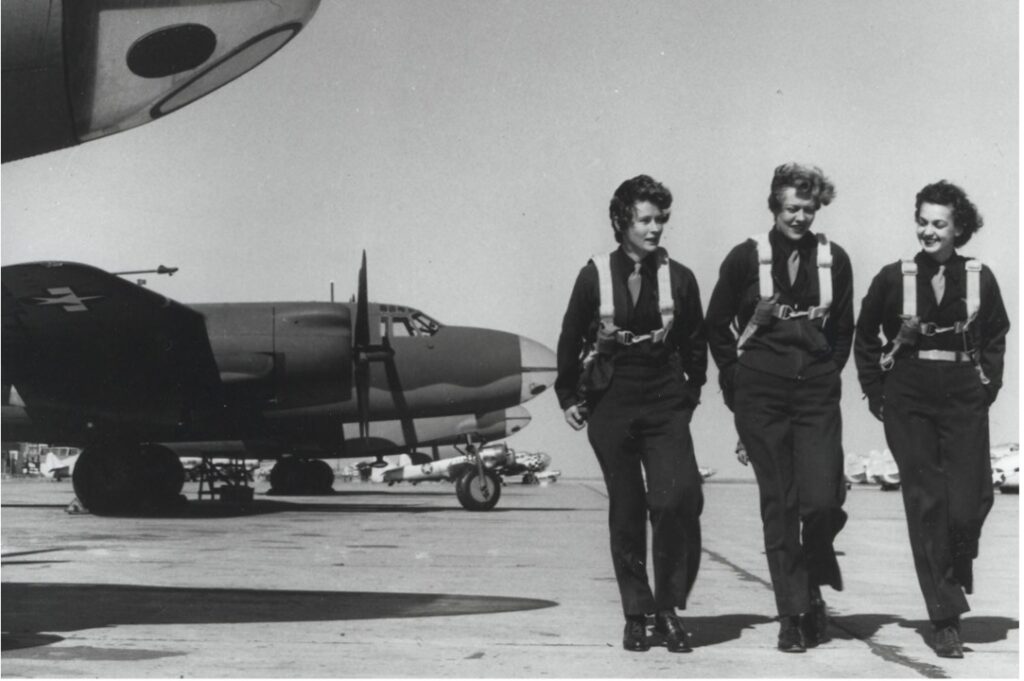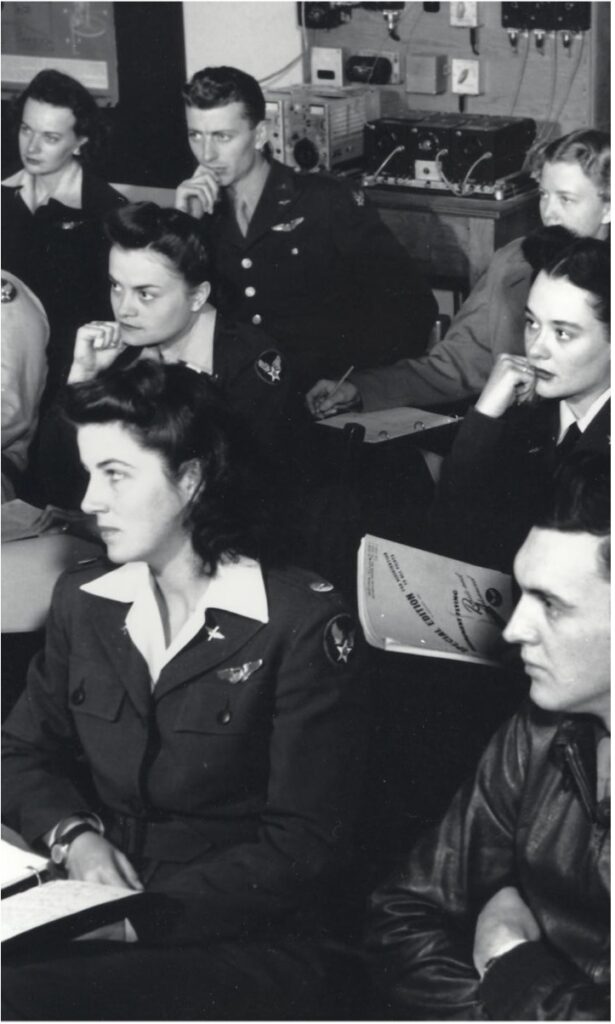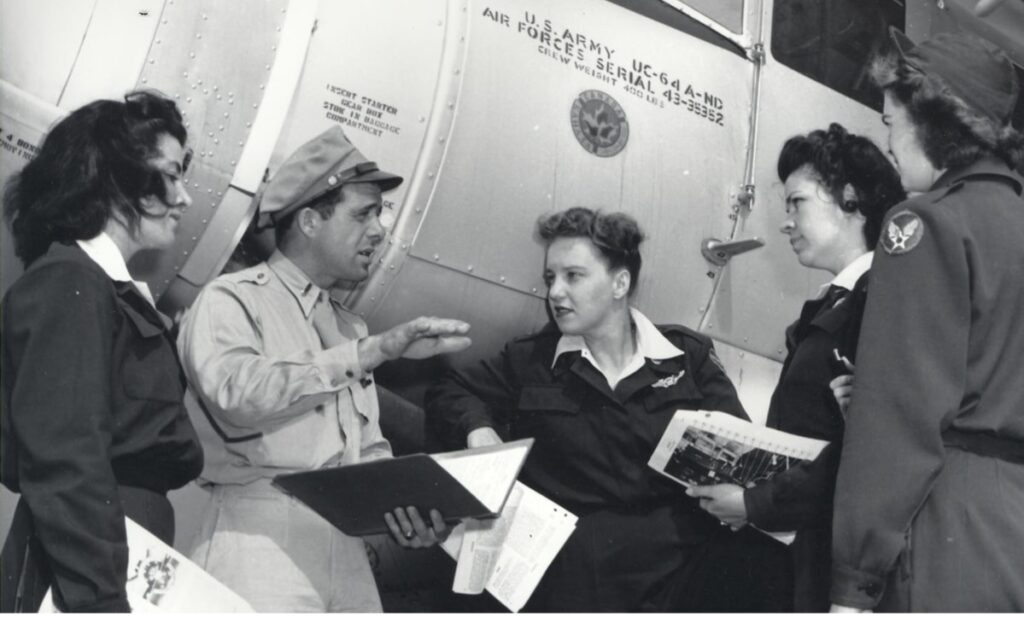
WASPs on runway, Laredo Texas, 1944. (www.afhistory.af.mil)
Introduction: The WASP
During World War II, the Army Air Forces sought out the assistance of women, mostly in peripheral, non-combat roles. Instead of allowing them to enlist as active-duty members, the Army Air Forces permitted women to form auxiliary groups that accomplished tasks on the home front as men fought overseas. The WASP, or Women Air Force Service Pilots, were one of these female groups, made up of the Women’s Flying Training Detachment and the Women’s Auxiliary Ferrying Squadron, joining together in 1943. These women provided critical support to the Army Air Forces in World War II.
WASPs took on the challenge of breaking through cultural and social norms to become effective pilots, but still faced challenges after the war. They led successful missions that supported Army Air Forces activities in the continental United States and helped train pilots for critical missions that would lead to the end of the war. However, after the war ended, WASPs struggled for recognition as pilots with legitimate experience. Overshadowing their success stories was the absence of veteran status and a postwar community unfamiliar with their capabilities and contributions as pilots. Many of these women came from Utah or eventually settled their roots here. Utah WASPs aided in critical missions that supported the United States’ war effort. Their stories, described here, illustrate a unique perspective of women during World War II, and how their impact allowed more female involvement in the armed services to this day.
Breaking the Mold: The Role of the WASP

WASPs in classroom, Romulus Army Airfield, Michigan, 1944. (www.afhistory.af.mil)
Before the outbreak of World War II, women who wanted to fly often faced significant barriers as a minority group among pilots. One local example of this was Alberta Hunt Nicholson, who worked as an elementary school teacher in Hooper, Utah, near what would soon become Hill Field. Alberta had wanted to fly since the age of 13 when she paid for a ride in a Ford Tri-Motor. She had complained to the pilot that the flight had not been long enough and demanded a refund. After earning a degree in music education from the University of Utah in 1937, she taught piano lessons during the summers to raise money for flying lessons. She eventually joined a ground instruction class in Salt Lake City and was the only woman out of 100 students, finishing in the top 10 percent of her class. Although she qualified for a scholarship to receive flight training, her application for the grant was denied and returned with the note, “No Females.” Despite this setback, she continued to raise funds for flight training and eventually accepted a spot in the WASP flight training school. Her niece, Maretta Jones, later said, “I don’t think she felt there was anything she couldn’t do. Whatever she wanted, she moved the earth to get it.” Alberta was later stationed at Luke Field, Arizona, with several other WASPs as test pilots, making sure fighters, bombers, and reconnaissance planes were fit to fly after repairs.
While WASPs, like Alberta, did not travel overseas, some of them still experienced dangers in their roles. Non-combat roles such as test pilot, pilot instructor or aircraft ferry pilot were common jobs for most WASP, and their missions stayed in the U.S. However, others, like Nell Bright and Dorothy Sorensen, towed aerial targets behind their planes in flight so that anti-aircraft ground crews could practice shooting. By towing targets, Bright and Sorensen provided vital training to Airmen who needed to test and practice their assigned equipment for combat readiness. Years later, Bright joked that even though she never saw combat she “still got shot at.”
Nell Bright’s role as a female pilot took people by surprise, as well. On one occasion, she was flying a B-25 to a refueling station in Long Beach, California, but the control tower would not respond to her radio messages. After several of her attempts, Air Traffic Control finally responded, “Get off the line! We’re trying to land a B-25.” She had to tell them, “We are the B-25.” When she finally landed, the men confessed, “They did not know there were women flying military aircraft.”
Challenging Fear: Women at Wendover
At a critical moment in the war, WASP contributed to the important work of helping train pilots in Utah for the first atomic mission. As the weapon delivery system for the Manhattan Project, the development of the B-29 Silverplate started as a way of carrying atomic bombs for specialized bombing missions. Utah’s West Desert became an important strategic area for training the crews of these large bombers because the isolated location and ideal weather conditions made it the perfect place to get ready for a top-secret mission. However, getting pilots to fly the planes was a difficult task for Lt. Colonel Paul Tibbets, who was commissioned to train the crews. Several pilots had heard rumors that the Air Force had rushed the plane into production and did not want to fly them. To ease his pilots’ fears, Lt. Colonel Tibbets turned to the WASP. He traveled to Eglin Field, Florida, and asked the WASP in training there who had experience flying dual-engine aircraft. He wanted women with experience whom he could train on the B-29. Dora Dougherty and Dorothea “Didi” Johnson Moorman raised their hands and traveled to Wendover along with another pilot, Mary Helen Gosnell, to help in this effort. Within five days of training, Dougherty was fully trained on the B-29 and ready to pass off as an aircraft commander. She and Didi flew multiple demonstrations where they were the only two pilots on the plane. Mary Helen Gosnell also frequently flew the B-29 as Lt Tibbets’ co-pilot. Near the end of the mission, the WASPs dubbed one of their B-29s Ladybird, and painted it with nose art of the WASP mascot Fifinella, a character illustrated by Walt Disney for a planned film on Roald Dahl’s work The Gremlins.

WASPs, Romulus AAF, 1944. (www.afhistory.af.mil)
Rejoining the Community: After the War
After the war was over, many WASP struggled to remain in the flight industry, eventually taking non-pilot jobs or leaving the career field entirely. The Army Air Forces inactivated WASP at the end of 1944 (eight months before the end of the war) as the need for pilots decreased. Several female pilots sought to join other branches of civil service as aircraft communicators, who work from the ground to inform and connect aircraft in the sky. Marjorie Redding Christiansen, originally from Montana, had served in Missouri at the Independence Army Air Force Basic Training School, flying repaired BT-14s. After the war, she retrained in Pacific Palisades, California, then moved to Fairfield, Utah, where she worked as an aircraft communicator. Unlike Marjorie, other WASPs felt they did not know exactly where to turn. Nell Bright recounted that several of these women wanted to use their impressive flight resumes by applying to become commercial pilots. She recollected that the airlines turned them down immediately. “A lot of people didn’t believe us. They hadn’t heard of the WASP. Airlines wouldn’t even talk to us.” Bright, along with two of her friends hopped in her car and rode down to Luke Field, Arizona, landing jobs as soda jerks. Bright later became a stockbroker and moved to Salt Lake City, Utah.
Sharing Their Story
Despite the important role that WASP played in the war on the home front, they initially did not receive the honors they deserved; and their unique contributions and stories did not become widely known for several years. Lack of notoriety or veteran’s status made WASP one of “the best kept secret[s] of World War II,” as Nell Bright called them. Many of these women, like Dorothy Sorensen from Taylorsville, Utah, or Naoma Renny Halladay from Murray, Utah, performed their service and went home quietly, got married or started families without sharing many of their stories from the war. After the war ended, WASP did not immediately receive veteran status or receive the celebrations and acknowledgments that many veterans experienced after they returned home. For the 38 women who died during training or service, their families had to pay to transport their bodies home and they did not receive flags for their caskets or their families.
Despite this lack of commendation, the work of these WASPs did not fail to make an impact. Their efforts enabled and strengthened the training of the armed forces as they helped train cadets, flew demonstrations, ferried aircraft, towed targets for practice shooting and other assignments. WASP finally received veteran status in 1977, just two years after the U.S. Air Force announced that they would allow women to enter pilot training along with male, active-duty pilots. Though their veteran status came much later, WASP set a precedent for the female pilots who came after them by showing their reliance and ability to participate in these vital missions, and we continue to celebrate their legacy by sharing their stories today.
